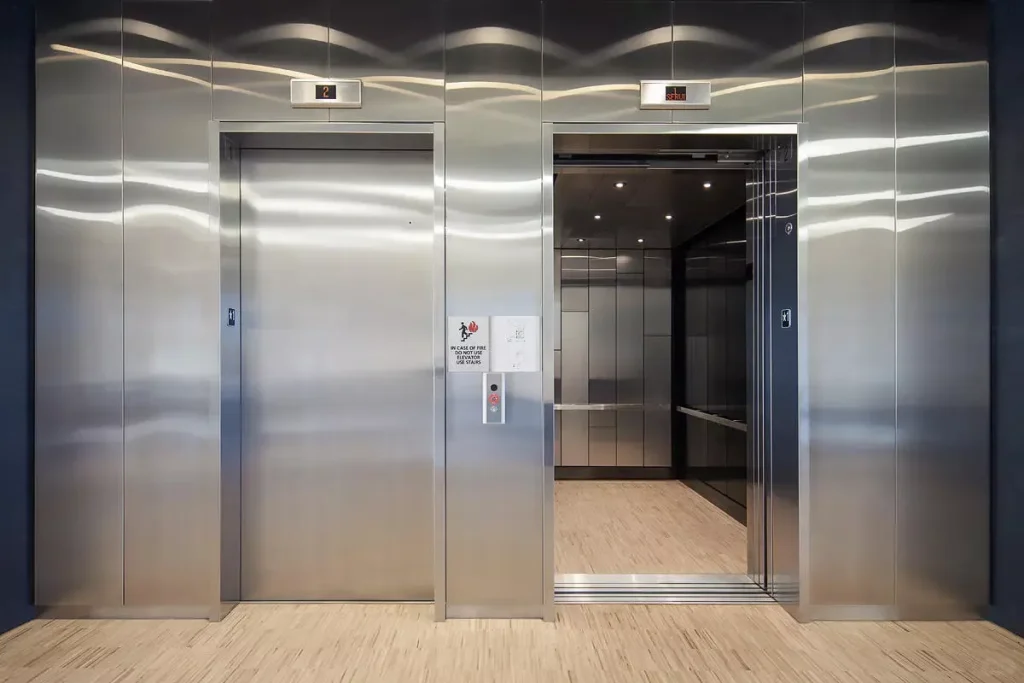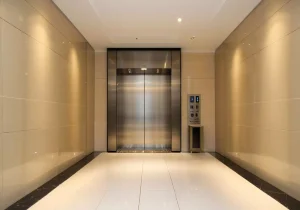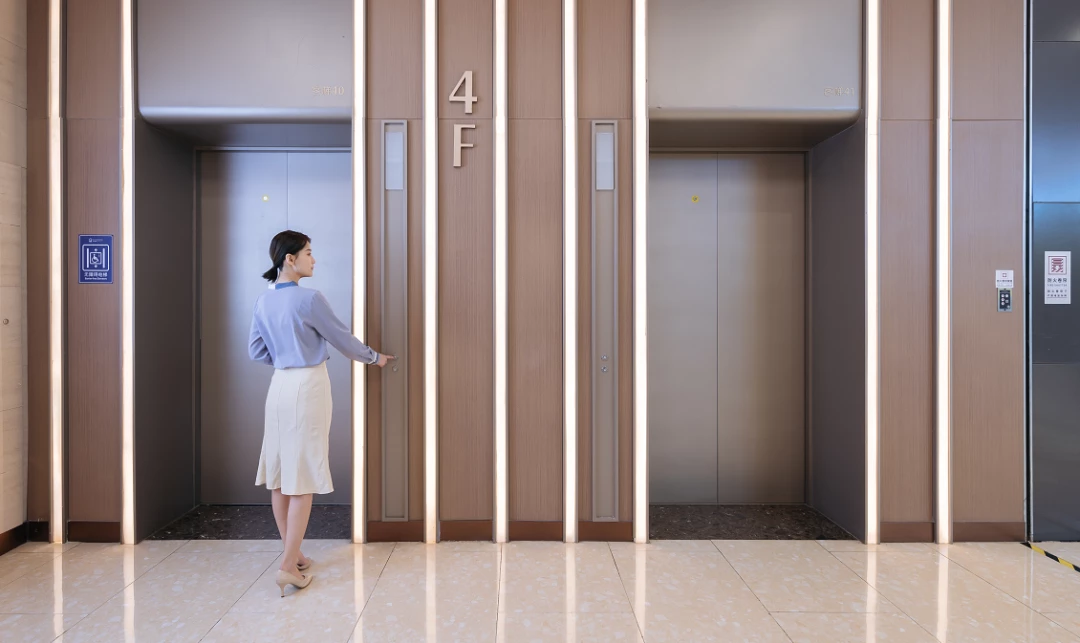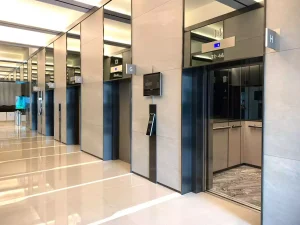Elevator doors are more than just panels that open and close. They play a vital role in ensuring
For builders, architects, and property managers, choosing the right type of elevator door is not only a matter of design but also of compliance, maintenance, and long-term reliability. With so many elevator doors types available—ranging from automatic elevator doors to manual elevator doors—understanding the differences is crucial.
What is an Elevator Door?
Components of an Elevator Door
An elevator door is made up of several key components that work together to ensure smooth, safe, and reliable operation. The door panels are the visible parts that passengers see and interact with; they slide or fold to open and close the entrance and are usually made of steel, glass, or aluminum depending on design requirements. These panels move along door tracks with the help of rollers, which ensure smooth and quiet motion while reducing wear and tear.
The movement of the doors is powered by the door operator, a motorized mechanism that controls the speed, direction, and timing of opening and closing. Integrated with the operator are safety sensors that detect obstacles such as people or objects, preventing the doors from closing until the path is clear. To further guarantee safety, door locks ensure that the elevator cannot move unless the doors are fully closed.
All these components are coordinated by the control system, which synchronizes door operation with the elevator’s overall movement, regulating speed, timing, and sensor inputs. Additional parts like guides and stoppers keep the doors aligned and prevent them from sliding beyond their intended range. In some elevators, optional features such as fire-resistant panels, soundproofing materials, or access control readers are integrated into the door assembly to meet specific safety, comfort, or security requirements.
What Are Elevator Doors Used For?
Elevator doors serve more than just the obvious purpose of providing entry and exit. They protect passengers from falling into the shaft, help reduce energy loss by minimizing air exchange between floors, act as a sound barrier, and contribute to a building’s interior design. Some doors integrate access control systems to restrict floor access, while fire-rated doors help contain fire and smoke during emergencies. Sensors and control systems also allow for real-time monitoring and easier maintenance, ensuring both safety and long-term reliabili
Who Invented Elevator Doors?
The story of elevator doors is closely tied to innovation in safety. In 1887, Alexander Miles, an American inventor of African descent born in Ohio, patented the automatic elevator door system. Before his design, passengers or attendants had to manually shut both the shaft and car doors—an oversight that often led to tragic accidents. Miles’s mechanism automatically closed the shaft and cabin doors together, drastically reducing risks.
After filing his patent, his work attracted attention in the elevator industry, where safety improvements were urgently needed. His contribution paved the way for the modern elevator as we know it today. Although later companies refined and automated his concept with electric operators and sensors, the foundation was set by Miles.
This breakthrough not only influenced building safety codes but also inspired ongoing innovations. Today’s elevator doors—equipped with motion sensors, light curtains, and computerized operators—are descendants of that early invention, underscoring Miles’s pivotal role in elevator history
Types of Elevator Doors
Here’s a breakdown of the main types of elevator doors, their advantages and disadvantages, and typical application
| Elevator Door Type | Typical Opening Width | Pros | Cons | Common Applications |
|---|---|---|---|---|
| Center-Opening Doors | 900–2000 mm | Smooth and fast operation; balanced panels; space-efficient | Slightly higher cost; requires precise installation | Commercial buildings, shopping malls, hotels |
| Single-Slide Doors | 700–1200 mm | Simple and cost-effective; fewer moving parts | Slower for wide entrances; less visually balanced | Residential elevators, small commercial elevators |
| Two-Speed / Telescopic Doors | 1200–2500 mm | Wider opening without extra shaft width; elegant operation | Complex mechanism; higher maintenance | Large commercial elevators, airports, hospitals |
| Folding Doors | 600–900 mm | Fits in tight spaces; lightweight; easy to install | Noisy; slower; limited durability | Home elevators, small service lifts, dumbwaiters |
Center-Opening Doors
Center-opening doors are the most common type in commercial buildings. They consist of two panels that slide apart horizontally from the center. This design allows for quick and smooth operation, making it ideal for high-traffic areas. Center-opening doors are balanced and space-efficient, which means they require minimal shaft depth.
Advantages: These doors provide fast opening and closing, operate smoothly, and make efficient use of space. They are also aesthetically pleasing, which is important in modern office and commercial settings.
Disadvantages: They can be slightly more expensive than single-slide doors and require precise installation and alignment to function correctly.
Technical Uses: Commercial elevators, office buildings, shopping malls, hotels
Single-Slide Doors
Single-slide doors have one panel that slides to one side of the entrance. This is a simpler and more cost-effective design compared to center-opening doors, making them common in residential elevators and smaller commercial installations.
Advantages: Simple mechanism, fewer parts to maintain, and generally more affordable.
Disadvantages: They may be less visually balanced and open more slowly in wider entrances.
Technical Uses: Home elevators, small office elevators, light commercial use
Two-Speed or Telescopic Doors
Telescopic doors use multiple panels that slide over each other, allowing a wider opening without requiring more shaft width. They are ideal for large elevator cabins in busy commercial spaces.
Advantages: Can provide wider openings than single-slide doors while saving shaft space. Smooth and elegant operation for larger elevators.
Disadvantages: More complex mechanism, which increases maintenance needs and installation cost.
Technical Uses: Large commercial elevators, shopping centers, airports, hospitals
Folding Doors
Folding doors consist of multiple panels that fold like an accordion to open. They are compact and can be installed where space is limited, such as home elevators or dumbwaiters.
Advantages: Can operate in tight spaces, lightweight, and relatively easy to install.
Disadvantages: Operation is noisier and slower, and mechanical parts may wear faster. Limited aesthetic appeal and durability.
Technical Uses: Residential elevators, small commercial lifts, dumbwaiters, service lifts
Elevator Door Materials & Design Options
The choice of material affects both performance and aesthetics.
- Brushed / Mirror Stainless Steel – Durable and elegant.
- Tempered Glass – Modern, stylish, and often paired with panoramic elevators.
- Powder Coating & Custom Colors – Matches building interiors.
- OEM Customization – Tailored solutions for unique architectural styles
How Do Elevator Doors Work?
How Do Elevator Doors Work?
Elevator doors are essential safety and operational components of any lift system. Simply put, they control access to the elevator car and prevent accidents, all while opening and closing smoothly to allow passengers to enter and exit efficiently. Unlike a manual door in a house, elevator doors are mechanized and often fully automatic.
Elevator doors generally fall into two main categories: sliding doors and folding doors. Sliding doors are the most common, consisting of panels that move horizontally along tracks. These panels are powered by a door operator, which is a motorized mechanism that controls the speed, timing, and direction of movement. When a passenger presses a call button, the operator engages, sliding the panels apart to open the entrance. Once the passenger enters or exits, the panels close automatically.
Folding doors operate differently. Instead of sliding, multiple panels fold like an accordion to open. These are usually found in home elevators, dumbwaiters, or small service lifts where space is limited. Folding doors are compact but generally slower than sliding doors and require precise mechanical alignment to function reliably.
Safety is built into every elevator door. Sensors detect obstructions in the doorway, preventing the doors from closing if a person or object is in the way. Additionally, the door locking mechanism ensures that the elevator cannot move unless the doors are fully closed, eliminating the risk of passengers falling into the shaft.
Center-opening vs. Single-slide Doors
Center-opening doors consist of two panels that part from the center, providing a wide and balanced opening. Single-slide doors have only one panel that slides to one side, which is simpler but less space-efficient. In both cases, the door operator, sensors, and locking mechanisms work together to coordinate opening and closing with the elevator car’s movement.
Key Components in Action:
-
Door Panels: The visible sections that move to allow entry and exit.
-
Tracks and Rollers: Guide the panels smoothly along their path.
-
Door Operator: Powers the movement of the panels automatically.
-
Safety Sensors: Detect obstacles to prevent accidents.
-
Locks and Control System: Ensure the elevator only moves when doors are fully closed.
Through this combination of mechanical, electrical, and safety systems, elevator doors operate quickly, quietly, and reliably, ensuring both convenience and protection for passengers.
How to Choose the Right Elevator Door
Choosing the right elevator door is essential to ensure safety, efficiency, and a smooth passenger experience. Here’s a checklist of key factors to consider when selecting an elevator door for your building. This will help you pick a door that perfectly suits your needs.
1. Type of Elevator Door
The first thing to consider is the type of door that fits your elevator and building layout. Common types include center-opening, single-slide, telescopic, and folding doors.
-
Center-Opening Doors: Ideal for commercial buildings with high passenger traffic. They provide wide, balanced openings and operate quickly.
-
Single-Slide Doors: Cost-effective and simple, suitable for residential elevators or small commercial spaces.
-
Telescopic Doors: Multiple panels slide together to create wide openings without needing extra shaft width, perfect for large cabins.
-
Folding Doors: Compact and suitable for tight spaces, commonly used in home elevators or service lifts.
Choosing the correct type ensures smooth operation, maximizes space, and aligns with building aesthetics.
2. Safety Features
Safety is the most critical aspect of any elevator door. Modern doors come with sensors that detect obstacles, preventing the door from closing on passengers or objects.
Other safety considerations include:
-
Door Locks: Ensure the elevator only moves when doors are fully closed.
-
Fire-Rated Doors: Useful in high-rise or commercial buildings to contain smoke and fire.
-
Access Control Integration: For restricted floors, some doors can integrate with keycards or biometric systems.
Always select doors that comply with local building codes and safety standards.
3. Space and Shaft Requirements
Elevator doors require specific shaft dimensions to operate correctly. Sliding doors need room for panels to retract along tracks, while folding doors need vertical or horizontal clearance for folding mechanisms.
Check the shaft width, cabin size, and wall spacing before choosing a door type. A door that doesn’t fit properly can lead to operational issues and higher maintenance costs.
4. Durability and Materials
Elevator doors must withstand frequent use and potential impact. Common materials include steel, aluminum, and tempered glass. Consider the environment and traffic:
-
High-Traffic Commercial Elevators: Opt for durable, scratch-resistant materials like stainless steel.
-
Residential Elevators: Lightweight aluminum or decorative glass may be sufficient.
-
Outdoor or Industrial Elevators: Doors may need corrosion-resistant coatings and weatherproofing
5. Aesthetic and Design
Elevator doors are also a visible part of your building’s interior. Choose finishes, colors, and styles that complement the décor. Glass panels can make spaces feel open, while metal finishes provide a modern, professional look.
6. Maintenance and Longevity
Consider doors that are easy to maintain, with accessible components for servicing. High-quality rollers, tracks, and operators reduce the likelihood of malfunctions and prolong door lifespan.
Pro Tip: Before finalizing your choice, consult your elevator manufacturer or a certified installer. They can help match the right door type with your elevator model, building requirements, and local safety code







